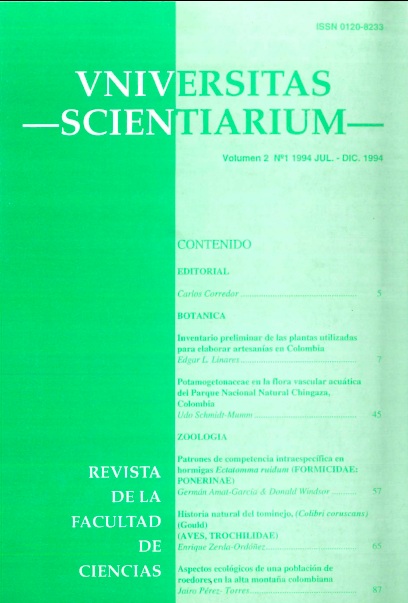Abstract
olibrí coruscans is distributed on both slopes of the Central and Eastem Andes of Colombia. However, there are no reports of this species in the Westem range of the Andes. This work was carried out in «Jardín Botánico de Bogotá» for nine months during which period, territorial, breeding and feeding behavior wasstudied, through 1125 hours of observa tion. In addition,
the nestling behavior during each one of the growing stages is described. Three different territorial spaces were established for Sparkling Violetear: one for display, one for nestling and another one for feeding. The former is the srnallest one and consists of only a tree branch; the nesting territory is 383m2 in size and that of feeding is 284 m2• Reproduction begins with male sexual display which consists of acrobatic flights done on one or between two trees; nest building last approximately seven days and incubation 16, with a constancy of 69%. Growing of nestlings take 21 days. The diet ofSparkling Violetear consists of nectar and insects; the former is obtained from 12 species of plants belonging to 9 families; the latter, wich was deterrilined by means of faecal bags analysis, was found to be made of insects belonging to 4 orders of which up to 60% were Díptera.
Univ. Sci. is registered under a Creative Commons Attribution 4.0 International Public License. Thus, this work may be reproduced, distributed, and publicly shared in digital format, as long as the names of the authors and Pontificia Universidad Javeriana are acknowledged. Others are allowed to quote, adapt, transform, auto-archive, republish, and create based on this material, for any purpose (even commercial ones), provided the authorship is duly acknowledged, a link to the original work is provided, and it is specified if changes have been made. Pontificia Universidad Javeriana does not hold the rights of published works and the authors are solely responsible for the contents of their works; they keep the moral, intellectual, privacy, and publicity rights. Approving the intervention of the work (review, copy-editing, translation, layout) and the following outreach, are granted through an use license and not through an assignment of rights. This means the journal and Pontificia Universidad Javeriana cannot be held responsible for any ethical malpractice by the authors. As a consequence of the protection granted by the use license, the journal is not required to publish recantations or modify information already published, unless the errata stems from the editorial management process. Publishing contents in this journal does not generate royalties for contributors.



